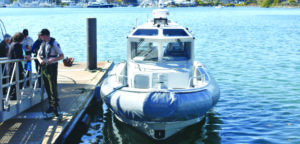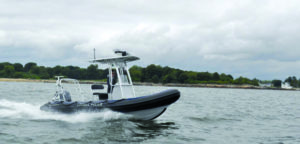U.S. boatbuilder Metal Shark brought a 38' Defiant patrol boat to the Multi-Agency Craft Conference last year in Baltimore. Along with its partner ASV Global, what set the team’s SharkTech patrol boat apart from the others was that it was an autonomous vessel, which can be custom configured for military, law enforcement, fire rescue, and other commercial markets.
At the time, Chris Allard, Metal Shark’s CEO, said, “The industry has watched and waited as autonomous technology has matured from its fledgling stages. We are demystifying and streamlining the process of autonomous technology integration by bringing this capability to market in turnkey form straight from the OEM (original equipment manufacturer).”
Beyond simple waypoint navigation or the execution of pre-programmed mission routes, Sharktech’s ASView onboard digital control system features a collision avoidance system with decision-making capability. The system allows for autonomous or remote operation of navigation and safety lighting, hailers and sirens, pumps, and other components.
It also permits the integration and autonomous or remote operation of a near-infinite range of specialized equipment, including fire pumps, monitors, and other firefighting equipment; hydrographic survey equipment; equipment for acoustic, oceanographic, or meteorological monitoring; and the full spectrum of FLIRs and other specialty cameras.
NEXT STEP
Recently, Metal Shark partnered with Sea Machines, a Boston-based developer of autonomous marine technology, to introduce a new 29' Sharktech autonomous vessel.
The new Sharktech 29 Defiant welded aluminum monohull pilothouse vessel features original OEM-integrated Sea Machines technology that offers a full range of advanced capabilities including active control and collision avoidance. The system allows for either traditionally manned, reduced crew or unmanned autonomous operations.
The two companies recently began demonstrations using the new platform, and units are now available for acquisition by government and commercial operators under Metal Shark’s stock boat program.
“This relationship came about earnestly because Sea Machines and Metal Shark share the mutual goal of bringing advanced autonomous marine technology to the market now,” said Don Black, Sea Machines vice president, sales and marketing. “One of the reasons Metal Shark chose to work with us was because we are one of the few companies that has autonomous marine systems commercially and readily available — meaning we have systems in stock, ready for installation on all types of workboats and a variety of commercial and government vessels now.”
Autonomous vessels are certainly of interest to naval officials who have been looking for ways to keep personnel safer during drug interdiction operations and in war zones. The Sea Machines-Metal Shark autonomous surface vessel package was developed using the SM300 vessel intelligence system that provides “operator-in-the loop” autonomous command and control, plus direct remote-control operation via wireless belt pack. “This system is configured for over-the-horizon detection as it pertains to collision avoidance, using radar and AIS sensors,” said Black.
Other features of the system include:
- Autonomous command for more productive, predictable and safer marine operations;
- Remote-helm control for faster responses and reduced operational costs;
- Remote payload control for on-board equipment cameras, sensors and more;
- Collaborative operations for a force-multiplier effect;
- Overall reduced manual effort that allows human operators to focus on higher-level tasks.
- Advanced mission planning and situational awareness capabilities round out the autonomous package. Routine software updates allow for system enhancements as additional refinements are made.
Black said the Sea Machines system can increase the productivity, predictability and safety of marine operations while helping to reduce incidents related to fatigue, poor visibility and challenging environments. “In terms of lowering risk and operational cost, unmanned operations can reduce stop-work periods and eliminate shift changes, which further increases productivity and safety,” he said.
The Sea Machines technology suite is designed to integrate into a versatile, military-proven hull form. Powered by twin outboard engines, the vessel has top speeds over 45 knots. The 29 Defiant can be customized to meet unique mission requirements. However, to reduce lead times, a standardized configuration has been developed for the stock boats program.
Yet the autonomous vessel is not just for military operations. “Sea Machines and Metal Shark are well matched for municipality, county, or state agency operations, including patrol, security, environmental protection applications and more,” Black said.
OTHER DELIVERIES
After 9/11, the number of patrol boats built in the U.S. grew exponentially. Many of them were built to beef up or replace U.S. military assets. Through federal grants, states and municipalities have also added to their fleets. Many of these non-military boats are multimission vessels. In addition to patrolling, these boats’ missions include recreational rescue operations, firefighting and more.

The 31' Impact is the newest asset in Maine Marine Patrol's fleet. Brunswick Commercial and Government Products photo
Here’s some of the non-military patrol/multimission boats delivered over the past year:
- Brunswick Commercial and Government Productsdelivered a new 31' fisheries and recreational boating enforcement and maritime security boat to Maine Marine Patrol in South Portland, Maine. TheImpact is the newest asset in Maine Marine’s fleet. The boat is powered by twin 350-hp Mercury Verado outboards capable of speeds of more than 50 knots. The new patrol boat is stationed at the South Portland Coast Guard facility. The boat was purchased with two grants totaling $300,000.
- The St. Croix County Sheriff’s Office in Hudson, Wis., took delivery this summer of a 24' custom-built rigid hull inflatable boat (RIB). The new boat, built by Lake Assault Boats, Superior, Wis., enhances the sheriff’s patrol capabilities and water-based emergency rescue operations on a 27-mile stretch of the St. Croix River, a National Scenic Riverway. Lake Assault’s 24' craft features an overall height of less than 13'6" and a person and cargo capacity of 3,000 lbs. It is able to operate in as little as 21" of water for easier access to shallow areas. The boat is outfitted with a bow-to-beach access door and ladder located at the front “V” of the bow. The hull is protected by a full protective collar around the gunwales, and also features a T-top pilothouse with 76" of headroom. The dash console provides room for electronics and includes a 16" touchscreen that integrates a forward looking infrared (FLIR) system, GPS, maps, chart plotter, and sonar with structure and side scan.

19' police boat's responsibilities include a large beach, collegiate rowing clubs and boathouses, and growing weekend recreational boating activity. Ribcraft photo
Located on the Merrimack River in Massachusetts, the Lowell Police Department took delivery of a new 19' Ribcraft 5.85 for patrol and enforcement duties as well as search and rescue operations. The new Ribcraft increases the department’s on-water presence and visibility and expands its response capabilities on an increasingly busy stretch of water with good public access, a large beach, collegiate rowing clubs and boathouses, and growing weekend recreational boating activity. Featuring a forward positioned center console with windscreen, an upgraded aluminum T-top, antenna arch with integrated dive ladder, the 19' RIB provides a comfortable platform for long patrols while offer ing an open deck and easy access to the water for diving and rescue. In addition to serving the police department, the new boat also provides water access for the Lowell Fire Department during dive team and medical rescue operations. Originally designed as a surf rescue craft, the Ribcraft 5.85 is small enough to maneuver in shallow waters yet large enough to carry ample crew and gear and handle large seas.
- Moose Boats, Vallejo, Calif., delivered a 38'10"×13'10" M2-38 catamaran CBRN, dive and fire rescue vessel to the San Francisco Fire Department. SFFD’s Marine Unit responds to hundreds of shoreline and open-water search and rescue calls a year so the new M2 is outfitted with a cabin roof observation tower and an array of high-powered searchlights. The M2 is outfitted with an integrated dive/recovery platform and a bow ladder for beach rescues. It is also equipped with a Halefire pump withLogan Clutch PTO flowing in excess of 1,500 gpm of fire suppression water, radiation detection equipment and CBRN positive pressure cabin air filtration. A heavy-duty push knee enables the M2-38 to come in contact with larger vessels and the city’s piers. Main propulsion comes from twin Cummins QSB6.7 425-hp turbo diesel engines connected to HamiltonJet HJ292 waterjets through Twin Disc MG-5075Sc marine gears. The boat’s electronics include a Simrad multifunction navigation screen, radar and 3-D side scan sonor, L3 Maritime Systems AIS, FLIR stabilized thermal imaging camera, and Motorola and Icom communications radios.





